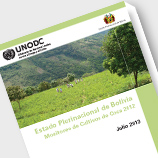
05 August 2013 - The cultivation of coca bush decreased by around 7 per cent in the Plurinational State of Bolivia, according to the 2012 national coca monitoring survey presented today by UNODC and the Bolivian Government. In 2012, the area under cultivation stood at around 25,300 hectares (ha), down from the previous year's figure of some 27, 200 ha. This decline confirms the downward trend noted in 2011, when cultivation fell by 12 per cent since 2010.
Antonino De Leo, UNODC Representative in Bolivia, whose office has been jointly producing the annual survey with the Bolivian Government since 2003, hailed this continuing positive trend.
Satellite images and ground surveys recorded declines in the three largest coca-producing regions: Yungas de La Paz, responsible for just over two thirds of Bolivia's coca cultivation, experienced a 7 per cent decrease to 16,900 ha; Cochabamba Tropics, which accounts for a nearly a third of coca cultivation, registered a 6 per cent reduction to 8,100 ha; and the northern provinces of La Paz, taking a 1 per cent share of cultivation, witnessed a 14 per cent drop to 320 ha.
Coca cultivation is forbidden by Bolivian law in protected areas, including national parks. Overall, the country's protected areas recorded a 9 per cent decrease in coca cultivation, from some 2,360 ha in 2011 to around 2,150 ha last year. The national park of Isiboro Secure, which accounts for half of coca cultivation in protected areas, registered a 4 per cent reduction to around 1080 ha, while Carrasco, a national park responsible for over 40 per cent of coca cultivation in protected areas, witnessed a 15 per cent decrease to 930 ha.
Decreasing levels of coca cultivation in Bolivia were brought about by a combination of Government-led eradication efforts, as well as dialogue with farmers and social incentives. In 2012, the Government eradicated some 11,000 ha of coca crop, up 5 per cent over the 2011 figure of 10.500 ha. At the provincial level, the area cleared in Cochabamba Tropics extended to over 8,200 ha, while the figure reached in the Yungas de la Paz was over 2,500 ha.
In 2012, the volume of coca leaf traded in the authorized markets of Villa Fátima and Sacaba weighed 18,400 mt, equivalent to 41 per cent of total coca leaf yield. About 94 per cent of the authorized trade took place in Villa Fatima, with the remaining 6 per cent being conducted in Sacaba.
Coca leaf prices decreased 5 per cent, fetching $7.4 per kg in the country's two Government-authorized markets. As a result, the total value of coca leaf also went down 7 per cent from US$ 353 million in 2011 to $ 332 in 2012. This represents 1.2 per cent of the country's GDP and 13 per cent of the GDP value of the agricultural sector in 2012.
Seizures of coca leaf rose sharply - 23 per cent - from some 600 mt in 2011 to almost 740 mt in 2012, while seizures of cocaine base rose 13 per cent from some 28 mt to around 32 mt. However, seizures of cocaine hydrochloride dropped 26 per cent from 5.6 mt in 2011 to 4.1 mt in 2012.
Speaking at the press conference, Mr. De Leo encouraged national and local authorities to continue reducing coca crop surplus by further enhancing alternative livelihood and counter-narcotics enforcement programmes. He added that "UNODC will continue to offer its support to these efforts of the Plurinational State of Bolivia, facilitating and promoting regional and international cooperation for the benefit of the entire society."
Estado Plurinacional de Bolivia - Monitoreo de Cultivos de Coca 2012
For more information, please contact:
In La Paz: Mr . Antonino De Leo, Representative, Plurinational State of Bolivia Tel. (+591-2) 2624-365
In Vienna: Ms. Preeta Bannerjee, Public Information Officer, Tel: +43- 1 26060-5764, Email: preeta.bannerjee[at]unodc.org